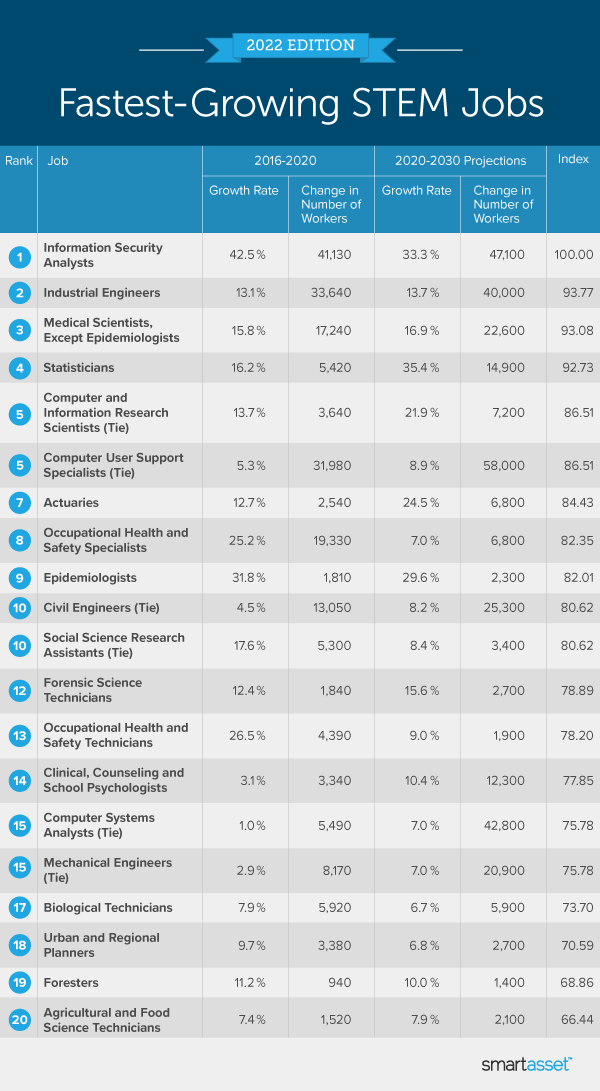Over the next 10 years, the Bureau of Labor Statistics expects there to be 821,300 new openings for STEM jobs, according to recent estimates. This represents a roughly 9% increase in the number of STEM jobs in the U.S. However, not all STEM jobs are projected to grow at the same rate.
In this study, SmartAsset took a closer look at the fastest-growing STEM jobs in the U.S., comparing both growth over the past four years and expected growth over the coming 10 years. Specifically, we compared 74 occupations across four metrics: percentage employment change from 2016 to 2020, gross change in employment from 2016 to 2020, projected percentage change in employment from 2020 to 2030 and projected gross change in employment from 2020 to 2030. For more information on our data or how we put together our findings, read our Data and Methodology section below.
This is SmartAsset’s third annual study on the fastest-growing STEM jobs in the U.S. Check out the 2021 version here.
Key Findings
- Computer and mathematical occupations continue to dominate. The Bureau of Labor Statistics (BLS) sorts STEM jobs according to three primary categories: computer and mathematical occupations; architecture and engineering occupations; and life, physical and social science occupations. Of the total 74 jobs we considered, five of the top 10 fastest-growing STEM jobs are computer and mathematical occupations. This is similar to last year when six of the top 10 fastest-growing STEM jobs fell under the category of computer and mathematical occupations.
- For many STEM jobs, researchers predict a slower annual growth rate of the next 10 years. On average, the top 10 fastest-growing STEM jobs in our study grew by about 18% from 2016 or 2020. That amounts to an annual growth rate of 4.25%. Over the coming 10 years, however, the BLS expects growth for many of those occupations to slow. The average expected annual growth rate from 2020 to 2030 is 1.83% across the top 10 occupations.

Computer and Mathematical Occupations
Like last year, information security analysts ranks as the fastest-growing STEM job across all occupations in our study. From 2016 to 2020, the occupation added more than 41,100 workers, marking an increase of 42.46%. Over the next 10 years, the number of information security analysts is expected to grow by another 47,100 workers, or a percentage increase of 33.3%.
The four remaining computer and mathematical occupations include statisticians, computer & information research scientists, computer user support specialists and actuaries. Of those, the occupation of statisticians is expected to grow at the quickest rate over the coming decade. The BLS estimates that the number of statisticians will grow by 35.4% – the highest across all 74 STEM occupations in our study – from 2020 to 2030. However, in terms of gross number of job openings, computer user support specialists takes the lead, with the BLS expecting 58,000 more workers in 2030 than 2020.
Architecture and Engineering Occupations
Only two architecture and engineering occupations rank in our list of the top 10 fastest-growing STEM jobs. They are industrial and civil engineers, ranking second and 10th, respectively. The BLS expects employment of industrial engineers to grow as quickly over the next 10 years as it did over the previous four years, at a rate of roughly 13%. Meanwhile, at No. 10, the occupation of civil engineer ranks sixth overall for both its four-year growth in number of workers (13,050) and expected 10-year growth in number of workers (25,300).
An additional two architecture and engineering jobs make the list of the top 25 fastest-growing STEM jobs. There are mechanical engineers, at No. 16, and electrical engineers, at No. 22. Both occupations rank best in terms of the gross number of workers added to the occupation between 2016 and 2020 and the number of workers expected to join the occupation in the coming 10 years. Specifically, there were 8,170 and 1,450 more mechanical and electrical engineers in 2020 than in 2016. The BLS predicts that there will be 20,900 and 12,700 more mechanical and electrical engineers in 2030 than 2020.
Life, Physical and Social Science Occupations
Three life, physical and social science occupations rank in our top 10. They include medical scientists, occupational health & safety specialists and epidemiologists. In light of the COVID-19 pandemic, the expected 10-year growth rate for both medical scientists and epidemiologists is high. According to 2020-2030 projections, the BLS expects the number of medical scientists to increase by 16.9% – or 22,600 workers – and the number of epidemiologists to increase by 29.6% – or 2,300 workers.
The third top-ranking life, physical and social science occupation is occupational health & safety specialists. Workers in this occupation typically provide data and analysis on work environments and procedures to ensure worker safety. Across the four metrics we considered, this job ranks best for its growth over the previous four years. From 2016 to 2020, the number of occupational health & safety specialists grew by 19,330, or an increase of more than 25%.
Data and Methodology
The Bureau of Labor Statistics (BLS) defines science, technology, engineering and math (STEM) occupations as including computer and mathematical; architecture and engineering; and life and physical science occupations, as well as managerial and postsecondary teaching occupations related to those functional areas and sales occupations requiring scientific or technical knowledge at the postsecondary level. For the purposes of this report, we considered only occupations falling under the first three categories.
To find which STEM jobs are growing the fastest, we compared 74 BLS-defined occupations across the following four metrics:
- Four-year percentage change in number of workers. Data comes from the Bureau of Labor Statistics and is for 2016 to 2020.
- Four-year growth in number of workers. This is the gross increase in number of workers. Data comes from the Bureau of Labor Statistics and is for 2016 to 2020.
- 10-year expected percentage growth in number of workers. Projections come from the Bureau of Labor Statistics and are for 2020 to 2030.
- 10-year expected growth in number of workers. This is the gross increase in number of workers. Projections come from the Bureau of Labor Statistics and are for 2020 to 2030.
Using the four metrics above, we ranked each occupation in every metric, giving all metrics an equal weighting. We then found each occupation’s average ranking and used the average to determine a final score. The occupation with the best average ranking received a score of 100. The occupation with the lowest average ranking received a score of 0.
Tips for Maximizing Your Paycheck
- Contribute to a 401(k) or IRA. One of the best ways to save is through a retirement savings account. A 401(k) is an employer-sponsored defined contribution plan in which you divert pre-tax portions of your monthly paycheck into a retirement account. Some employers will also match your 401(k) contributions up to a certain percentage of your salary, meaning that if you chose not to contribute, you are essentially leaving money on the table. Our 401(k) calculator can help you determine what you saved for retirement so far and how much more you may need. If your employer does not offer a 401(k) plan, an IRA is another great option.
- Seek out trusted advice. No matter where you live, a financial advisor can help you get your financial life in order. Finding a qualified financial advisor doesn’t have to be hard. SmartAsset’s free tool matches you with up to three financial advisors in your area, and you can interview your advisor matches at no cost to decide which one is right for you. If you’re ready to find an advisor who can help you achieve your financial goals, get started now.
Questions about our study? Contact us at press@smartasset.com
Photo credit: ©iStock.com/skynesher
